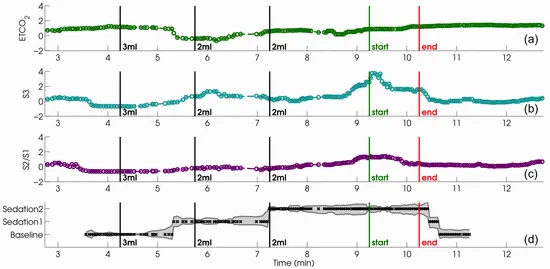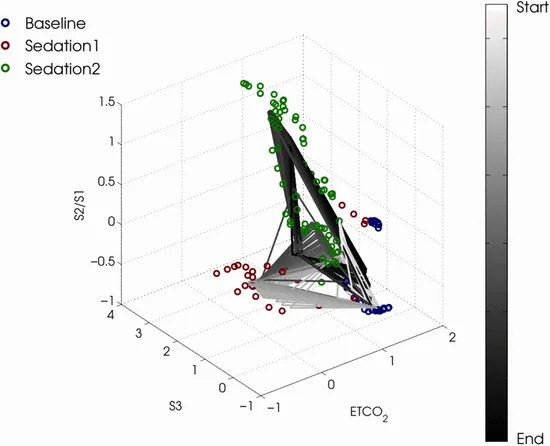Procedural Sedation Monitoring: Systems and Methods for Predicting Adverse Events and Assesing Level of Sedation
This invention is a system for monitoring sedation state and detecting adverse events during procedural sedation. The system can be implemented in a standalone monitor or incorporated into commercially available monitoring systems within clinical settings.
Researchers
-
systems and methods for predicting adverse events and assessing level of sedation during medical procedures
United States of America | Granted | 10,388,405 -
systems and methods for predicting adverse events and assessing level of sedation during medical procedures
United States of America | Granted | 11,972,843
Figures
Technology
Following the 2011 guidelines of the American Society of Anesthesiologists, capnography, a noninvasive measurement of exhaled carbon dioxide, has become the standard of care for ventilation monitoring of sedated patients. This invention quantitatively identifies a patient's sedation level and predicts adverse events based on information from the capnogram and outputs from pharmacokinetic, pharmacodynamics or ventilatory models. This system is comprised of a breath receiver, a sensor and a processor. The sensor measures the carbon dioxide concentration of air exhaled by the patient into the breath receiver. The processor processes the sensor data to generate capnograms, and computes the outputs of pharmacokinetic, pharmacodynamic and ventilatory models. The processor also extracts the resulting features from these models and a multi-parameter metric is computed based on the extracted features to determine the current or predicted sedation level of the patient. Assessing an individual's ventilatory state during sedation provides a unique perspective on patient's clinical status. In particular, parameter extraction and predictive methods derived from capnography and other physiological data can improve the safety and operational effectiveness of the sedation.
Problems Addressed
Procedural sedation has allowed many painful procedures to be conducted outside the operating room. During such procedures, it is important to maintain an appropriate level of sedation to minimize the risk of respiratory depression (if the patients are over-sedated) or pain or anxiety (if under-sedated). However, there are no objective, data-driven means to measure a patient's evolving level of sedation during a procedure. Currently, clinicians use light physical or verbal stimulation to gauge the degree of the patient's responsiveness as a surrogate measure of sedation level. Furthermore, the current patient safety monitoring can detect but not predict adverse events. Therefore, despite the high level of surveillance offered by the standard monitoring systems in place today, adverse respiratory events, such as apnea and hypoxemia, frequently occur.
Advantages
- Respiratory-focused patient monitoring system
- Helps reduce subjectivity from clinical decision making with respect to individual sedation and respiratory state
- Predicts adverse respiratory events
Publications
Mieloszyk, R. J., et al. "Clustering of Capnogram Features to Track State Transitions During Procedural Sedation." In 2015 37th Annual International Conference of the IEEE Engineering in Medicine and Biology Society (EMBC), 1699-1702. doi: 10.1109/EMBC.2015.7318704.
Hardesty, L. "Diagnostic Exhalations." MIT News, November 6, 2014.
License this technology
Interested in this technology? Connect with our experienced licensing team to initiate the process.
Sign up for technology updates
Sign up now to receive the latest updates on cutting-edge technologies and innovations.


